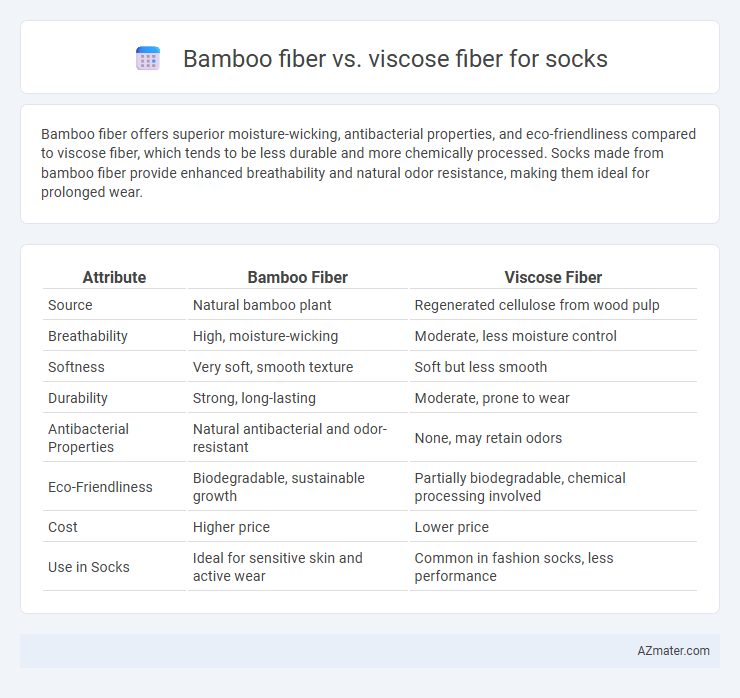Bamboo fiber offers superior moisture-wicking, antibacterial properties, and eco-friendliness compared to viscose fiber, which tends to be less durable and more chemically processed. Socks made from bamboo fiber provide enhanced breathability and natural odor resistance, making them ideal for prolonged wear.
Table of Comparison
| Attribute | Bamboo Fiber | Viscose Fiber |
|---|---|---|
| Source | Natural bamboo plant | Regenerated cellulose from wood pulp |
| Breathability | High, moisture-wicking | Moderate, less moisture control |
| Softness | Very soft, smooth texture | Soft but less smooth |
| Durability | Strong, long-lasting | Moderate, prone to wear |
| Antibacterial Properties | Natural antibacterial and odor-resistant | None, may retain odors |
| Eco-Friendliness | Biodegradable, sustainable growth | Partially biodegradable, chemical processing involved |
| Cost | Higher price | Lower price |
| Use in Socks | Ideal for sensitive skin and active wear | Common in fashion socks, less performance |
Introduction to Bamboo Fiber and Viscose Fiber
Bamboo fiber, derived from the cellulose of bamboo plants, is celebrated for its natural antibacterial properties, high breathability, and eco-friendly cultivation, making it ideal for socks that require moisture-wicking and odor resistance. Viscose fiber, produced from chemically processed wood pulp, offers a softer, silk-like texture and excellent dye retention but involves a more intensive manufacturing process with environmental concerns. Both fibers provide comfort and softness for sock applications, yet bamboo fiber stands out for sustainability while viscose is valued for versatility in fabric blends.
Understanding the Manufacturing Processes
Bamboo fiber is derived from natural bamboo pulp through a mechanical or chemical process that breaks down the plant into soft, biodegradable fibers, emphasizing eco-friendly production methods with minimal chemical use. Viscose fiber, a type of rayon, is produced via a chemical-intensive process that transforms wood pulp or bamboo into regenerated cellulose fibers using carbon disulfide and other solvents, often raising environmental concerns. Understanding these manufacturing differences highlights bamboo fiber's sustainability advantage versus viscose's cost-effectiveness and versatility in sock production.
Environmental Impact: Bamboo vs. Viscose
Bamboo fiber production for socks involves a more sustainable cultivation process, requiring less water and pesticides compared to viscose fiber derived from wood pulp, which often leads to deforestation and chemical pollution. Bamboo is a fast-growing grass that can be harvested yearly without replanting, whereas viscose manufacturing emits toxic chemicals like carbon disulfide, posing environmental and health risks. Choosing bamboo fiber socks reduces ecological footprint through renewable resources and lower chemical usage, making them a more eco-friendly alternative to viscose-based options.
Comfort and Softness Comparison
Bamboo fiber offers superior moisture-wicking properties and natural antibacterial benefits, making socks highly breathable and odor-resistant, which enhances overall comfort. Viscose fiber, derived from cellulose, provides a silky smooth texture and excellent softness but lacks the antimicrobial features of bamboo. Socks made from bamboo fiber maintain comfort over prolonged wear, while viscose socks deliver a luxurious feel with moderate moisture control.
Moisture-Wicking and Breathability
Bamboo fiber exhibits superior moisture-wicking properties compared to viscose fiber, efficiently drawing sweat away from the skin to maintain dryness in socks. Its natural micro-gaps and hollow structure enhance breathability, allowing increased airflow and reducing overheating during wear. Viscose, while breathable due to its cellulose origin, lacks the advanced moisture management capabilities of bamboo fiber, often resulting in less effective moisture control in socks.
Durability and Longevity in Socks
Bamboo fiber offers superior durability and longevity in socks due to its natural strength and resistance to wear, making it ideal for prolonged use and frequent washing. Viscose fiber, while soft and smooth, tends to degrade faster under regular abrasion and moisture exposure, reducing the lifespan of socks made from this material. Bamboo socks maintain their shape and integrity longer, providing consistent comfort and performance over time.
Antibacterial and Odor-Resistant Properties
Bamboo fiber socks exhibit superior antibacterial and odor-resistant properties due to the natural presence of bamboo kun, a bio-agent that inhibits bacterial growth and reduces odor. Viscose fiber, although derived from cellulose like bamboo, undergoes extensive chemical processing that diminishes its inherent antibacterial capabilities, making it less effective against odor buildup. The moisture-wicking ability of bamboo fiber further enhances breathability and reduces sweat accumulation, contributing to a fresher, more hygienic sock experience compared to viscose.
Cost and Accessibility for Consumers
Bamboo fiber socks typically cost more than viscose fiber socks due to the eco-friendly processing methods and sustainable sourcing involved. Viscose fiber, derived from wood pulp, benefits from established manufacturing processes that lower production costs and increase market accessibility. Consumers seeking affordable options often find viscose fiber socks more readily available in mainstream retail outlets compared to bamboo fiber alternatives.
Eco-Friendly Certifications and Claims
Bamboo fiber socks often carry certifications such as OEKO-TEX Standard 100 and GOTS, ensuring organic cultivation and non-toxic processing aligned with eco-friendly standards. Viscose fiber, derived from wood pulp, may have certifications like FSC (Forest Stewardship Council) but frequently involves chemical-intensive processes raising environmental concerns. Eco-conscious consumers prioritize bamboo fiber socks for their renewable source and lower environmental impact, whereas viscose fibers require scrutiny on certification validity to confirm sustainability claims.
Which Fiber Is Best for Socks?
Bamboo fiber offers superior breathability, natural antibacterial properties, and moisture-wicking capabilities, making it ideal for socks in terms of comfort and hygiene. Viscose, while soft and absorbent, lacks the inherent antimicrobial benefits and environmental sustainability of bamboo fiber. For the best combination of durability, comfort, and eco-friendliness in socks, bamboo fiber is the preferred choice.

Infographic: Bamboo fiber vs Viscose fiber for Sock
 azmater.com
azmater.com